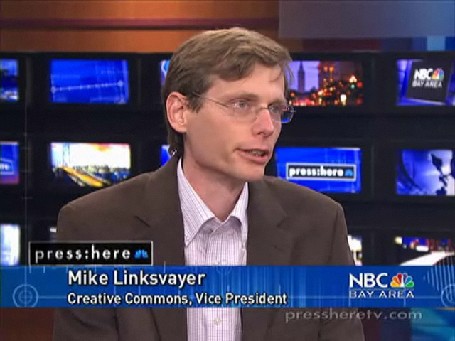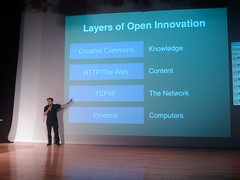
Last Sunday I appeared (mp4 download) on a tech interview program called Press: Here. It went ok. Most of the questions were softball and somewhat repetitive. Lots more could have been said about any of them, but I think I did a pretty good job of hitting a major point on each and not meandering. However, one thing I said (emphasized below) sounds like pure bs:
this has been done in the open source software world for a couple decades now and now that people are more concerned about the content layer that’s really part of the infrastructure having a way to clear those permissions without the lawyer-to-lawyer conversation happen every single time is necessary
I could’ve omitted the bolded words above and retained the respect of any viewer with a brain. What the heck did I mean? I was referring to an argument, primarily made by Joi Ito over the last year or so, using a stylized version of the layers of a protocol stack. David Weinberger’s live-blogging of Ito provides a good summary:
Way back when, it was difficult to connect computers. Then we got Ethernet, then TCP/IP, and then HTTP (the Web). These new layers allow participation without permission. The cost of sending information and the cost of innovation have gone down (because the cost of failure has gone down). Now we’re getting another layer: Creative Commons. “By standardizing and simplifying the legal layer … I think we will lower the costs and create another explosion of innovation.â€
Protocol geeks may object, but I think it’s a fairly compelling argument, at least for explaining why what Creative Commons does is “big”. The problems of not having a top layer (I called it “content”, the slide photographed above says “knowledge” — what it calls “content” is usually called “application”, and the note above says “legal”, referring to one required mechanism for opening up permissions around content, knowledge, or whatever one wishs to call it) in which a commons can be taken for granted (ie like infrastructure) is evident, for example in the failure by lawsuit of most interesting online music services, or the inaccessibility of much of the scientific literature to most humans and machines (eg for data mining), as are powerful hints as to what is possible where it exists, for example the vast ecology enabled by Wikipedia’s openness such as DBpedia.
I didn’t make that argument on-screen. Probably a good thing, given the previous paragraph’s tortured language. I shall practice. Critique welcome.
…
Press: Here is broadcast from its SF bay area home station (NBC) and I’ve heard is syndicated to many other stations. However, its website says nothing about how to view the program on TV, even on its home station. I even had a hard time finding any TV schedule on the NBC Bay Area website — a tiny link in the footer takes one to subpages for the station with lame schedule information syndicated from TV Guide. I found this near total disconnect between TV and the web a very odd, but then again, I don’t really care where the weird segment of the population that watches TV obtains schedule information. Press: Here ought to release its programs under a liberal CC license as soon as the show airs. Its own website gets very little traffic, many of the interviews would be relevant for uploading to Wikimedia Commons, and the ones that got used in Wikipedia would drive significant traffic back to the program website.

[…] Explaining away cringeworthy language http://gondwanaland.com/mlog/2009/07/25/content-layer-infrastructure/ […]
I knew what you meant … but we work in the same field … I never really thought of CC as a way to simplify sharing without a lawyer … but for those that normally go this route … I guess it is really time / cost saver. For most of us it is just a more structured way of sharing that we most likely would not have thought about.
The JITS people who shared the video around on facebook really liked it.
The audience is different, Mike – I think pulling in Joi Ito’s abstraction of the protocol stack more would have been a mistake, but it is good that you worked your way around it so that the more geeky in the audience might make it fit.
You can please some people some of the time… you know? :-)
Thanks John and Taran. Maybe that line didn’t sound as vacuous as I feared.
Structured sharing is probably a better way to think of it than altering the cost structures of those who would normally go to a lawyer. Distributed collaboration can’t tolerate that sort of cost structure, thus the need for “structured sharing” … that’s why I brought up “scaling”.
I’m probably a bit geekier than the average user, but I still found your use of the term “content layer” a bit confusing and “tech jargony.” Another talking point I would have tried to get in there more explicitly is that CC is not just about doing away with the trouble of lawyers, but that it offers a tool for social practice and community building founded on values different from those found in the most restrictive form of copyright.
And by “user,” I meant “viewer.” I clearly spend way more time on the Internets than in front of the telly.
leesean, all true. May more viewers become users.
By the way, a couple other Ito mentions of CC and a new layer found on the web. Etech session abstract:
CC fundraising message:
Great job Mike. The host’s mangling of copyright law at the beginning made me wince a bit.
I didn’t think it was a big deal. It was clear to me what you meant.
I think you have to allow that sometimes, not everyone will understand every single thing outside their domain.
In this case, you used words that everyone has some understanding of, and the fact that you were making a precise technical analogy would, I think, to most people, look just like a bit of unclear wording they can still follow.
I think it suffered more from the sentence being too long, without any cues.
Perhaps:
This has been done in the open source software world for a couple decades now. But now people are more concerned about the content. Think of the content as a separate layer, on top of the software and communication infrastructure. We need a way to clear content permissions without the lawyer-to-lawyer conversation every single time.
[…] the “media” items my name has appeared in are indeed about Creative Commons, i.e., me doing my job, not me as primary subject, or in a few cases, about calorie restriction, with me as a prop. Or […]